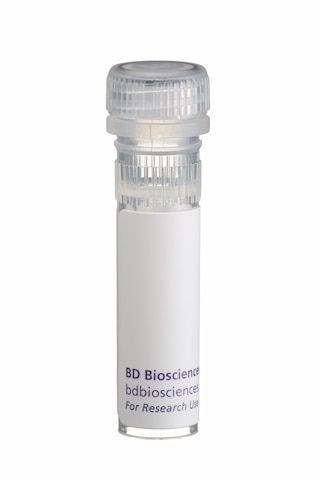-
Reagents
- Flow Cytometry Reagents
-
Western Blotting and Molecular Reagents
- Immunoassay Reagents
-
Single-Cell Multiomics Reagents
- BD® AbSeq Assay
- BD Rhapsody™ Accessory Kits
- BD® Single-Cell Multiplexing Kit
- BD Rhapsody™ Targeted mRNA Kits
- BD Rhapsody™ Whole Transcriptome Analysis (WTA) Amplification Kit
- BD Rhapsody™ TCR/BCR Profiling Assays for Human and Mouse
- BD® OMICS-Guard Sample Preservation Buffer
- BD Rhapsody™ ATAC-Seq Assays
-
Functional Assays
-
Microscopy and Imaging Reagents
-
Cell Preparation and Separation Reagents
-
Training
- Flow Cytometry Basic Training
-
Product-Based Training
- BD FACSDiscover™ S8 Cell Sorter Product Training
- Accuri C6 Plus Product-Based Training
- FACSAria Product Based Training
- FACSCanto Product-Based Training
- FACSLyric Product-Based Training
- FACSMelody Product-Based Training
- FACSymphony Product-Based Training
- HTS Product-Based Training
- LSRFortessa Product-Based Training
- Advanced Training
-
- BD® AbSeq Assay
- BD Rhapsody™ Accessory Kits
- BD® Single-Cell Multiplexing Kit
- BD Rhapsody™ Targeted mRNA Kits
- BD Rhapsody™ Whole Transcriptome Analysis (WTA) Amplification Kit
- BD Rhapsody™ TCR/BCR Profiling Assays for Human and Mouse
- BD® OMICS-Guard Sample Preservation Buffer
- BD Rhapsody™ ATAC-Seq Assays
-
- BD FACSDiscover™ S8 Cell Sorter Product Training
- Accuri C6 Plus Product-Based Training
- FACSAria Product Based Training
- FACSCanto Product-Based Training
- FACSLyric Product-Based Training
- FACSMelody Product-Based Training
- FACSymphony Product-Based Training
- HTS Product-Based Training
- LSRFortessa Product-Based Training
- United States (English)
-
Change country/language
Old Browser
This page has been recently translated and is available in French now.
Looks like you're visiting us from {countryName}.
Would you like to stay on the current country site or be switched to your country?


.png)

Flow cytometric analysis of MSR1 (CD204) expression on human monocyte-derived macrophages. Freshly isolated human monocytes were cultured (6 days) with Recombinant Human GM-CSF protein (Cat. No. 550068; 50 ng/ml). The cells were harvested with an enzyme-free cell dissociation solution, washed, and then stained with either PE Mouse IgG1, κ Isotype Control (Cat. No. 554680; dashed line histogram) or PE Mouse Anti-Human MSR1 (CD204) antibody (Cat. No. 566251; solid histogram). The histogram showing MSR1 (CD204) expression (or Ig Isotype control staining) was derived from gated events with the forward and side light-scatter characteristics of viable macrophages. Flow cytometric analysis was performed using a BD™ Canto II Flow Cytometry System.
.png)

BD Pharmingen™ PE Mouse Anti-Human MSR1 (CD204)
.png)
Regulatory Status Legend
Any use of products other than the permitted use without the express written authorization of Becton, Dickinson and Company is strictly prohibited.
Preparation And Storage
Product Notices
- Since applications vary, each investigator should titrate the reagent to obtain optimal results.
- An isotype control should be used at the same concentration as the antibody of interest.
- Caution: Sodium azide yields highly toxic hydrazoic acid under acidic conditions. Dilute azide compounds in running water before discarding to avoid accumulation of potentially explosive deposits in plumbing.
- For fluorochrome spectra and suitable instrument settings, please refer to our Multicolor Flow Cytometry web page at www.bdbiosciences.com/colors.
- Please refer to www.bdbiosciences.com/us/s/resources for technical protocols.
Companion Products




The U23-56 monoclonal antibody specifically binds to Macrophage scavenger receptor 1 (MSR1) which is also known as CD204, Scavenger receptor A (SRA), Scavenger receptor class A member 1 (SCARA1), or Macrophage acetylated LDL receptor I and II. MSR1 is a trimeric type II transmembrane glycoprotein that belongs to the type 1 class A scavenger receptor family. MSR1 functions as a scavenger receptor that enables mononuclear phagocytes to take up and respond to a variety of negatively charged macromolecules including oxidized and acetylated low density lipoproteins. MSR1 also functions in innate immunity as a pattern recognition receptor. MSR1 allows macrophages to recognize and respond to microbial products, such as lipopolysaccharide and polyribonucleic acids, by the production of cytokines and inflammatory mediators. MSR1 also reportedly serves as a coreceptor that regulates the signaling of some Toll-like receptors including TLR-3, TLR-4, and TLR-9. MSR1 has been associated with several diseases including atherosclerosis, Alzheimer's disease, ischemic injury, and sepsis. The U23-56 antibody was tested by flow cytometric and Western blot analyses of MSR1-transfected and untransfected cells to verify its specificity.

Development References (4)
-
Gough PJ, Greaves DR, Gordon S. A naturally occurring isoform of the human macrophage scavenger receptor (SR-A) gene generated by alternative splicing blocks modified LDL uptake.. J Lipid Res. 1998; 39(3):531-43. (Biology). View Reference
-
Higashi-Kuwata N, Jinnin M, Makino T, et al. Characterization of monocyte/macrophage subsets in the skin and peripheral blood derived from patients with systemic sclerosis.. Arthritis Res Ther. 2010; 12(4):R128. (Biology). View Reference
-
Hongo S, Watanabe T, Arita S, et al. Leptin modulates ACAT1 expression and cholesterol efflux from human macrophages.. Am J Physiol Endocrinol Metab. 2009; 297(2):E474-82. (Biology). View Reference
-
Zola H, Swart B, Nicholson I, Voss E. CD204. In: Zola H. Leukocyte and stromal cell molecules : the CD markers. Hoboken, N.J.: Wiley-Liss; 2007:347-348.
Please refer to Support Documents for Quality Certificates
Global - Refer to manufacturer's instructions for use and related User Manuals and Technical data sheets before using this products as described
Comparisons, where applicable, are made against older BD Technology, manual methods or are general performance claims. Comparisons are not made against non-BD technologies, unless otherwise noted.
For Research Use Only. Not for use in diagnostic or therapeutic procedures.
Report a Site Issue
This form is intended to help us improve our website experience. For other support, please visit our Contact Us page.